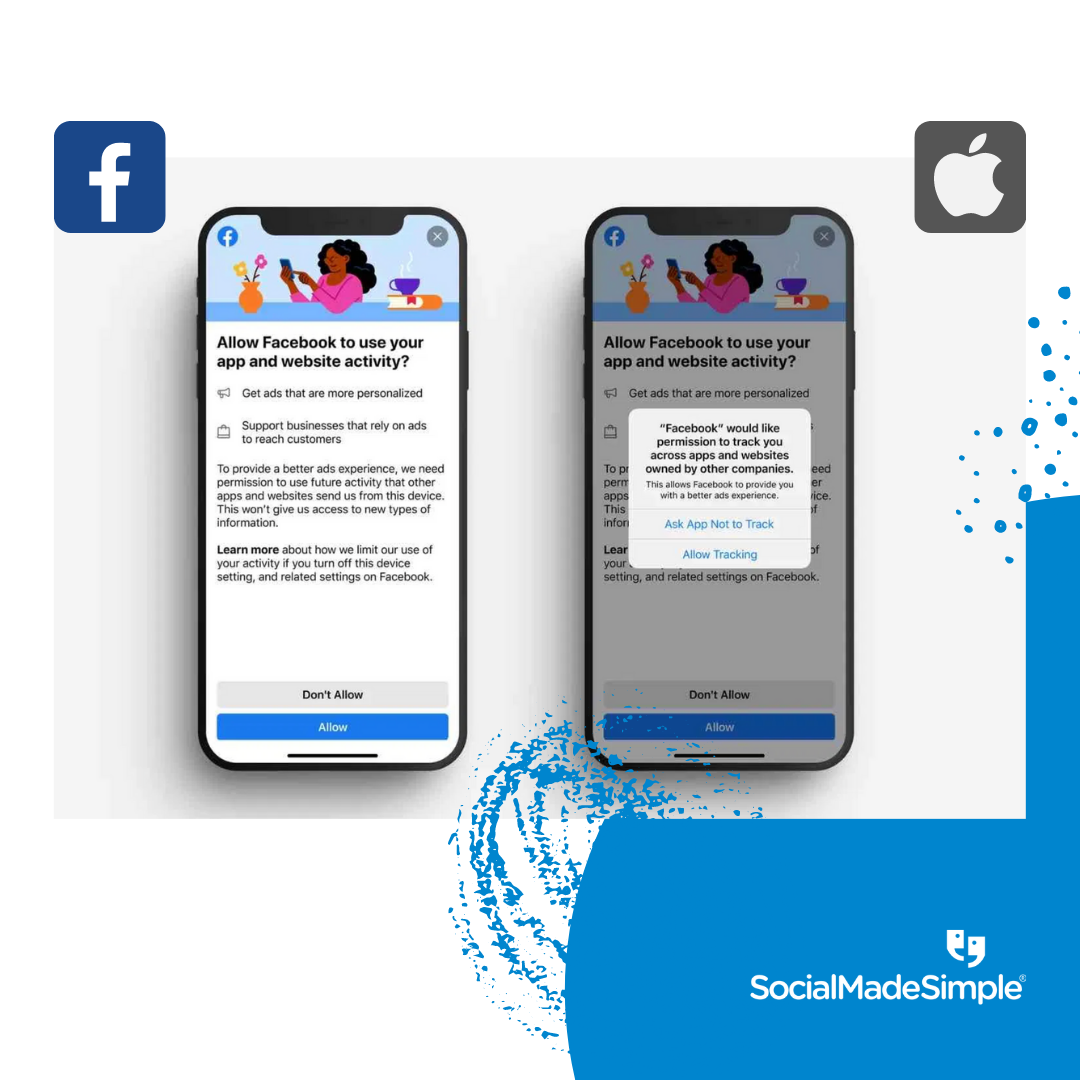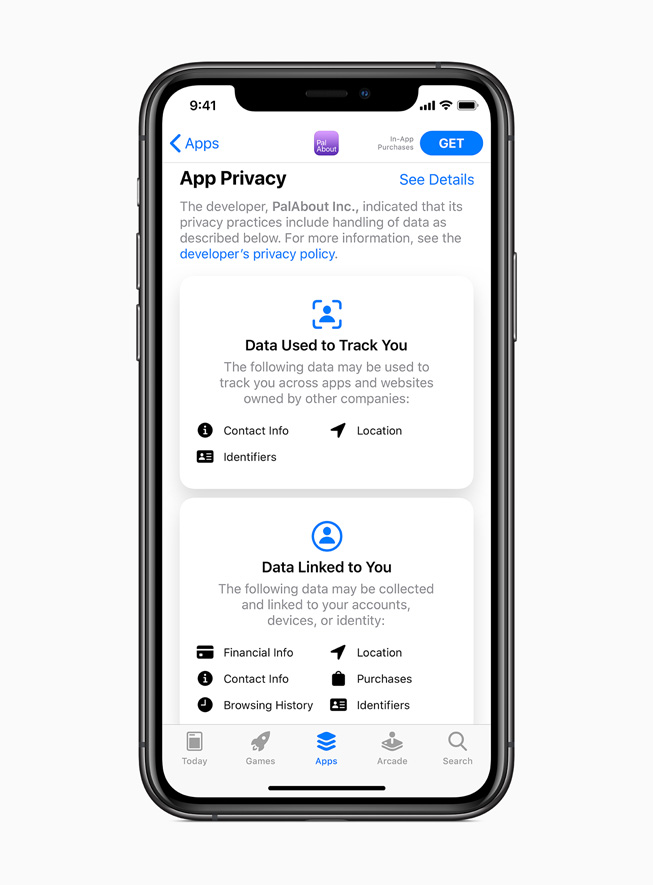What Advertisers Should Expect From Apple’s iOS 14.5 Impact (& How To Strategize Around It)

More privacy for users and more frustration for advertisers… That’s Apple’s newest update in a nutshell.
What’s the big deal about iOS 14.5? As of the week of April 26th, Apple is requiring apps in the App Store to ask users for permission through its AppTrackingTransparency (ATT) framework to track their activity across other apps and websites.
Marketers are now forced to return to the drawing board and strategize ways around the new privacy and data sharing policies. Apple’s iOS 14.5 impact on paid advertising could be bigger than we may think.
Apple’s iOS 14.5 primary impacts on advertising:
Limited Targeting Capabilities
When a device is updated to iOS 14.5, the user will see a pop-up with a prompt asking them to either allow or deny permission to collect and share data across other apps. From Facebook’s point-of-view, once the app is launched using a device with iOS 14.5, and the user has asked the app not to track, their system will detect the update and automatically opt the user out of tracking on that device. As you can probably imagine, it’s not expected that every Apple user will choose to opt-in to being tracked by apps which means: expect a fluctuating or significantly reduced audience size.
With Apple’s previous privacy and data sharing policies, Facebook could track user activity across other apps and websites, which allowed advertisers to retarget users who visited a business’s website or app and completed a certain action (adding items to the cart, visiting a landing page, etc.). Better yet – it allowed marketers to create personalized ads and put them in front of an audience who has already expressed an interest in the business. As Apple users gradually update devices to iOS 14.5, retargeted audiences will likely be the most heavily affected.
With certain targeting functions compromised, how will this affect the accuracy in measuring performance?
Inaccurate Performance Reporting
28-day click-through, 28-day view-through, and 7-day view-through attribution windows will no longer be supported for active campaigns, according to Facebook for Business.
An attribution window is the duration of time between when a person views or clicks on an advertisement and subsequently takes a marketing-defined action. Marketers use attribution windows to measure the impact of advertisements more accurately; although, they could now be losing conversion measurements due to users opting out of tracking.
Assume a 28-day attribution window for the following examples.
The first user views a video on Facebook and immediately goes to the advertiser’s website and purchases. In this case, the advertisement is likely the driving factor that led to the purchase. Because the purchase occurred within 28 days of the user seeing the ad, the ad receives credit for the purchase. Suppose a different user views a video on Facebook and 3 months later goes to the advertiser’s website and makes a purchase. It’s likely the video advertisement 3 months prior wasn’t the driving force that led to the purchase. Therefore, we don’t want to give the second advertisement full credit for purchases outside of a defined duration (the 28-day attribution window).
View-through attribution (AKA impression tracking) is what allows advertisers to collect data on a user’s actions after viewing the ad and before converting. Let’s say a user views your ad, makes multiple visits to a landing page over a period of time, and then finally converts. What used to be a 28-day view-through window now defaults to a 7-day click-through attribution window. Someone may be running a website conversion campaign, get a conversion (from an iOS user), and not be able to measure that conversion in the campaign. Campaigns now require a very methodical integration with conversion data to ensure that no measurements are being lost.
Click-through attribution is the time between when someone interacts with your ad (e.g. ad click) and converts. Compare 28-day and 7-day click conversions to understand how your reported conversions may be affected. If a user converts more than 7 days after clicking an ad, the advertisement won’t receive credit for the conversion.
In addition to these changes, the attribution window for all new or active ad campaigns will be set at the ad set level rather than at the account level.
Overall, the accuracy of performance reports will likely be impacted due to:
- 7-day click-through attribution window default.
- Data only includes people who consent to share data & only tracks a minor selection of objectives (up to 8 conversions per domain and 1 conversion per campaign).
- Delivery and action breakdowns (age, gender, region, and placement) will no longer be supported.
Immediate Impact on App Install Campaigns
If you are an app advertiser that does not support Apple’s SKAdNetwork API through a business tool integration (e.g. Facebook SDK) then you will no longer be able to create App Install campaigns that target iOS 14.5+ devices.
Similarly, for iOS 14 app install campaigns, reporting will also need to rely on data from Apple’s SKAdNetwork API for mobile app installs and other app conversion events. The goal of Apple’s SKAdNetwork is to provide advertisers with an understanding of app installs and campaigns without tracking specific user identities.
Strategies To Target Your Ideal Audience Regardless Of iOS 14.5
You still have Android users to think about: This update has zero effect on Android users, so don’t forget you can still segment your audience targeting by Android and iOS users. In a perfect world, you would want to track the data for both types of users, but with inaccurate reporting and limited targeting capabilities in the mix, this will do for now!
Leverage website tracking capabilities: Don’t underestimate the data still accessible to you from your very own website. By using analytics tools or your website’s tracking capabilities, you can gain insight into who is visiting your website and where they come from, then create a custom audience based on those visitors. You can systematically upload these custom audiences to Facebook, allowing for restarting.
Update to Facebook SDK (version 8.0+): If you use the Facebook SDK (Software Development Kit) for iOS, you must update to version 8.0 or above to create iOS 14 app install campaigns, as stated by Facebook for Business. Facebook SDK version 8.0+ is the business tool integration that will support Apple’s SKAdNetwork API and therefore allow you to measure the performance of app install ads. Keep in mind that if you use Facebook SDK for iOS but fail to update to version 8.0 or above, you will still be unable to create app install campaigns.
Prioritize your 8 most valuable conversion events: Prior to the release of Apple’s update, you could use the Facebook Pixel to install as many conversion events on your app or website as you’d like. Facebook Pixels collect data for optimizing and personalizing ads, as well as retargeting. If we weren’t talking about iOS 14.5, I would recommend installing as many events as you’d like, and on each page of your website, in order to get a full understanding of who your visitors are. However, iOS 14.5 is limiting advertisers to eight-pixel objectives on a single domain (and still excludes tracking of users who opt-out). Identify 8 conversion events that are of the highest value to your business (add to cart, subscribe, book an appointment, etc.) and continue to leverage Facebook pixels effectively.
Although it’s too early to tell what the true impact of Apple’s iOS 14.5 will look like for marketers, it’s never too early to prepare for whatever is to come. The world of digital marketing is constantly evolving and adapting to new trends, new software updates, and even new social media platforms.
Will iOS 14.5 really shake up paid advertising or will it just be a bump in the road for advertisers? Only time (& iOS users) will tell.
Client Success Stories
5 Fitness Franchise Locations Increase Facebook Page Reach Over 1K% & Generate 80+ Facebook Leads in a 90-Day Pilot
For 90 days, Camp Gladiator participated in a fitness franchise marketing pilot program where SocialMadeSimple executed a full social media marketing strategy designed to meet each of their needs seamlessly. Check out the results!
F45 Locations Use Facebook For Lead Generation & Drives 2K+ Leads & 2.6 Million Ad Views
F45 Training franchisees came to SocialMadeSimple in need of a strategy-driven solution that can utilize Facebook for lead generation in a way that’s cost-efficient, consistent, & effective. Learn how SocialMadeSimple makes the magic happen for seven F45 locations, driving gym membership sign-ups directly through Facebook & Instagram!
MaidPro Franchise Uses Social Media for Recruitment To Generate 50+ Job Candidates with Facebook Ads
MaidPro, a home cleaning franchise with 200+ locations, was in need of a social media marketing strategy that could effectively build brand awareness, drive sales, & generate qualified job candidates for each location. Today, we are MaidPro’s preferred social media vendor and continue their success using social media for recruitment. Check out the case study!







